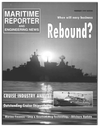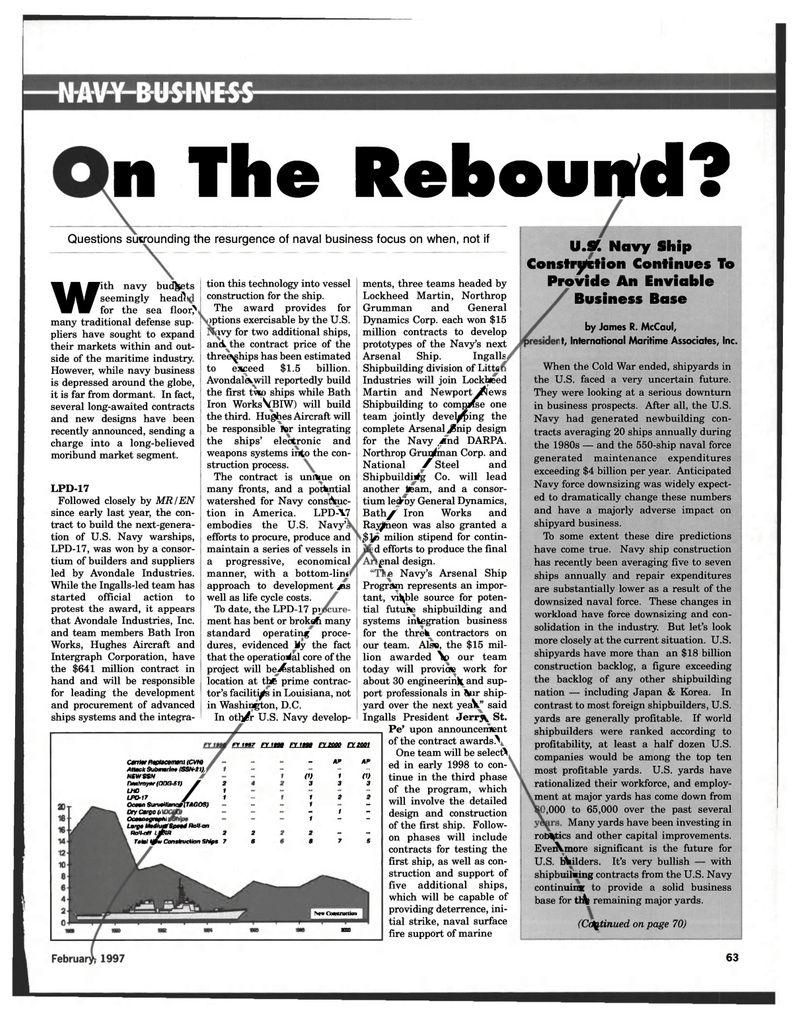
Page 63: of Maritime Reporter Magazine (February 1997)
Read this page in Pdf, Flash or Html5 edition of February 1997 Maritime Reporter Magazine
n The Rebound?
Questions surrounding the resurgence of naval business focus on when, not if
With navy budgets seemingly heacft for the sea floor^ many traditional defense sup- pliers have sought to expand their markets within and out- side of the maritime industry.
However, while navy business is depressed around the globe, it is far from dormant. In fact, several long-awaited contracts and new designs have been recently announced, sending a charge into a long-believed moribund market segment.
LPD-17
Followed closely by MR/EN since early last year, the con- tract to build the next-genera- tion of U.S. Navy warships,
LPD-17, was won by a consor- tium of builders and suppliers led by Avondale Industries.
While the Ingalls-led team has started official action to protest the award, it appears that Avondale Industries, Inc. and team members Bath Iron
Works, Hughes Aircraft and
Intergraph Corporation, have the $641 million contract in hand and will be responsible for leading the development and procurement of advanced ships systems and the integra- tion this technology into vessel construction for the ship.
The award provides for )ptions exercisable by the U.S. ivy for two additional ships, ancl the contract price of the three^hips has been estimated to exceed $1.5 billion.
Avondaleuvill reportedly build the first tm ships while Bath
Iron WorksVBIW) will build the third. Hughes Aircraft will be responsible Bor integrating the ships' electronic and weapons systems into the con- struction process.
The contract is uniVue on many fronts, and a pottoitial watershed for Navy construc- tion in America. LPDA7 embodies the U.S. Navy' efforts to procure, produce and maintain a series of vessels in a progressive, economical manner, with a bottom-liru approach to development ^as well as life cycle costs.
To date, the LPD-17 pi ment has bent or brokaft many standard operating proce- dures, evidenced My the fact that the operational core of the project will be^stablished on location at the prime contrac- tor's facilities in Louisiana, not in Washington, D.C.
In oth/r U.S. Navy develop- er rwr mm mm txxm ami
Canter Replacement (Cvm Attack Submarine ISSN-H).
NBV/SSH rumlmyor (OOG-S1) f 2
LHO / 1 LPD-17 /
Ocean Surveilltnae(TAGOS) Dry Cargo o
Oceanegraphi Largo Medium Speed Roll-on
Ftotl-nft IyS» 2 2 Total t0w Construction Ships 7 6
- AP AP
S
NrvOMHUwthn
20Q0
ments, three teams headed by
Lockheed Martin, Northrop
Grumman and General
Dynamics Corp. each won $15
million contracts to develop
prototypes of the Navy's next
Arsenal Ship. Ingalls
Shipbuilding division of Litta
Industries will join Lockbfeed
Martin and Newport^Jews
Shipbuilding to compulse one
team jointly devel^ing the
complete Arsenal jSnip design
for the Navy And DARPA.
Northrop Grun^man Corp. and
National / Steel and
Shipbuilding Co. will lead
another ieam, and a consor-
tium ledmy General Dynamics,
Bathyr Iron Works and
Ray^neon was also granted a
k$J(D milion stipend for contin-
d efforts to produce the final
f nal design.
s Navy's Arsenal Ship
Progrstoi represents an impor-
tant, viable source for poten-
tial future shipbuilding and
systems integration business
for the threk contractors on
our team. Also, the $15 mil-
lion awarded \> our team
today will proviofe work for
about 30 engineering and sup-
port professionals in Anr ship-
yard over the next yeaV' said
Ingalls President Jerry St.
Pe' upon announcement
of the contract awards.^
One team will be select^
ed in early 1998 to con-
tinue in the third phase
of the program, which
will involve the detailed
design and construction
of the first ship. Follow-
on phases will include
contracts for testing the
first ship, as well as con-
struction and support of
five additional ships,
which will be capable of
providing deterrence, ini-
tial strike, naval surface
fire support of marine
U.SC Navy Ship
Construction Continues To
Provide An Enviable
Business Base
by James R. McCaul,
t, International Maritime Associates, Inc.
When the Cold War ended, shipyards in
the U.S. faced a very uncertain future.
They were looking at a serious downturn
in business prospects. After all, the U.S.
Navy had generated newbuilding con-
tracts averaging 20 ships annually during
the 1980s — and the 550-ship naval force
generated maintenance expenditures
exceeding $4 billion per year. Anticipated
Navy force downsizing was widely expect-
ed to dramatically change these numbers
and have a majorly adverse impact on
shipyard business.
To some extent these dire predictions
have come true. Navy ship construction
has recently been averaging five to seven
ships annually and repair expenditures
are substantially lower as a result of the
downsized naval force. These changes in
workload have force downsizing and con-
solidation in the industry. But let's look
more closely at the current situation. U.S.
shipyards have more than an $18 billion
construction backlog, a figure exceeding
the backlog of any other shipbuilding
nation — including Japan & Korea. In
contrast to most foreign shipbuilders, U.S.
yards are generally profitable. If world
shipbuilders were ranked according to
profitability, at least a half dozen U.S.
companies would be among the top ten
most profitable yards. U.S. yards have
rationalized their workforce, and employ-
ment at major yards has come down from
,000 to 65,000 over the past several
Many yards have been investing in
robotics and other capital improvements.
EveiXmore significant is the future for
U.S. bWilders. It's very bullish — with
shipbuilding contracts from the U.S. Navy
continuing to provide a solid business
base for tb^ remaining major yards.
(Continued on page 70)
63

 62
62

 64
64
